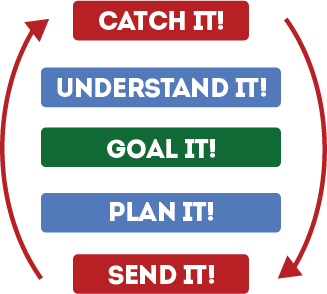Consultation Services for the therapeutic use of electronic media
> Signal Cycle Model
An approach for individuals with mild to moderate deficits in the areas of social interaction, communication, repetitive or restricted activities or interests, sensory integration, emotional regulation, attention, hyperactivity-impulsivity, and executive functions.
An approach that targets the recurring sequence of underlying skills involved in:

An approach that targets the recurring sequence of underlying skills involved in:
- Being aware of information in the environment and oneself, or CATCH IT!;
- Thinking about that information, or UNDERSTAND IT!, GOAL IT!, and PLAN IT!; and
- Conveying information back to the environment and oneself, or SEND IT!
- Appreciating how their behavior affects others;
- Expressing themselves or understanding others;
- Deviating from routines, adjusting to change, or shifting from one idea or task to another; tolerating intense sound, light, touch,smell, movement, or temperature;
- Recognizing and managing emotions;
- Maintaining focus or persisting on tasks; and
- Doing things in a logical sequence, planning and organizing, or managing time.
Diagnostically, the Signal Cycle Model is appropriate for a broad range of disorders, including autism, Asperger's, PDD NOS, NVLD, CAPD, learning disabilities, ADHD, ODD, anxiety and depression, and adjustment disorders.
The Signal Cycle Model uses the recurring sequence of skills as a strategy for assessing and developing parenting, treatment, and school intervention plans.
The Signal Cycle Model uses the underlying skills, separately and in combinations, for helping individuals and families learn social skills (Getting Along) and coping skills (Feeling Better).
The Signal Cycle Model is simple and easy to use in the home, classroom, office or any other setting and integrates well with other intervention models. For example, we incorporate the Signal Cycle Model as part of functional behavior analysis (FBSA).
Overview of the Signal Cycle Model
The Signal Cycle Model is like a toolbox filled with tools. It can be used for helping individuals get along with others. Sometimes this means teaching how to make and keep friends or how to improve relationships with family. Other times it may involve teaching how to respond appropriately to requests at home, school, or work. These skills are often referred to as social skills.
It can also be used for helping individuals feel better about themselves. For some this means learning to identify thoughts and feelings that are uncomfortable or stressful, for others the focus is on learning to manage their thinking and emotions. These skills are commonly referred to as coping skills.
The Signal Cycle is the toolbox. It organizes the tools in a way that make them easy to identify. For example, red boxes are for communication skills, blue boxes for thinking skills, and a green box for goal setting skills. The boxes are labeled with simple words to help even young children identify and remember them. The Signal Cycle shows the sequence for using the tools and the relationships between the tools – or which tools go together.
The Signal Skills are the tools. Communication skills come first because if we are not aware of information, or Signals, the other skills will not be used. For example, if your child is napping when you ask her to clean up her room before dinner, it is unlikely she will respond.
The Signal Skills for communication are Catch It! and Send It!. Catch It! is awareness of and attention to Signals you receive. For example, the words you are reading on this page, or your child reading your note to clean up her room before dinner.
Send It! is awareness of and attention to Signals you convey. For example, telling someone your favorite food, or your child telling you she thought your note meant cleaning her room tomorrow before dinner.
The next two tools, Understand It! and Plan It!, are for thinking about information. Understand It! is thinking about Signals you Catch, or information you receive. Plan It! is thinking about Signals you Send, or information you convey. For example, if your child does not respond to your request to clean up her room, you might check for whether she Caught your Signal by asking her to repeat what you said (Understand It!); if your child resists your request to clean up her room, you might help her list other Signals she could Send and possible consequences (Plan It!).
In one respect, the most important tool is Goal It!. Goal It! is the skill of setting goals for Getting Along and Feeling Better.
